Pine tip moths, Rhyacionia spp., are major forest pests in the United States. The Nantucket pine tip moth, R. frustrana (Comstock) (Fig. 1), is the most common and economically important tip moth species in the South. Its range extends from Massachusetts to Florida and west to Texas. It also has been introduced into California where it is now the key pest of Christmas tree farms. The primary hosts of the Nantucket pine tip moth are yellow pines including loblolly and shortleaf pines in the South and Southeast, Virginia, pitch and Scotch pines in New England and Middle Atlantic States and Monterey pine in California. Slash pine is highly resistant and longleaf pine is virtually immune to attack.
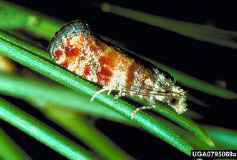
Figure 1. Adult Nantucket pine tip moth, Rhyacionia frustrana (Comstock) (photo by James Richmond via www.forestryimages.com)
Two other species of Rhyacionia are found in the eastern range and often infest the same trees as the Nantucket pine tip moth. These are the pitch pine tip moth, R. rigidana (Fernald), and the subtropical pine tip moth, R. subtropica Miller. The pitch pine tip moth is more prevalent and is difficult to distinguish from the Nantucket pine tip moth.Its range largely overlaps that of the Nantucket pine tip moth.The range of the subtropical pine moth is restricted to Florida and the southern parts of Georgia, Mississippi, and South Carolina. In California, the Nantucket pine tip moth attacks the same trees as the Monterey pine tip moth, R. pasadenana (Kearfott).Other important tip moth species include the introduced European pine shoot moth, R. boulinana, which attacks red pine in the Northeast and ponderosa pine in the Pacific Northwest, and the adana pine tip moth, R. adana, which attacks red, jack, and Scotch pines in the Great Lakes region.
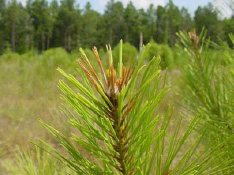
Figure 2. Loblolly pine shoot damaged by pine tip moth (photo by Don Grosman)
The Nantucket pine tip moth is most damaging to pine plantations and to wild and ornamental pine seedlings in open areas (Fig.2). It poses an ever increasing problem because of forestry trends that favor the establishment of large areas of pine plantations. In such areas, Nantucket pine tip moth damage may be very common. Tip moths may also be particularly damaging to pine seed orchards because they kill female flowers and conelets. The Nantucket pine tip moth has two to five generations annually throughout its range, with three to five generations occurring in the Western Gulf Region.They overwinteras pupae (light to dark brown and about 1/4 inch (6 mm) long) inside damaged shoots, cones, or buds. In southeast Texas, adults emerge from early February to mid-March and emergence is synchronized with new growth flushes from its primary host, loblolly pine. Gray scales cover their head, body, and appendages, except for the forewings, which are covered with brick-red and copper-colored patches separated by irregular bands of gray scales (Fig. 1).Mating occurs soon after emergence and is mediated by sex pheromones (female-produced chemicals that attract males). Eggs are often deposited on needles, and hatch within 14 days. They are slightly convex and about 1/32 inch (0.8 mm) in diameter (Fig. 3). It is opaque white when laid, but turns yellow to medium orange as it matures. First instar larvae (cream colored with a black head) either feed on the surface of new growth, causing shallow injuries, or bore into the needle bundles. Second instar larvae feed at needle and bud axils, where they construct a tent of silk covered with resin (Fig. 4). Subsequent instars (light brown to orange and about 3/8 inch (9 mm) long) feed inside buds and shoots. Second generation adults emerge five to six weeks after the first generation adults (mid-April to mid-May). Peak emergence of third, fourth and fifth generation adults occurs in late June, mid-August, and late September, respectively.
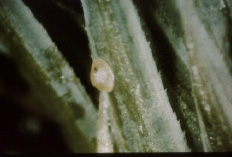
Figure 3. Pine tip moth egg on pine needle (Photo by R. Scott Cameron)
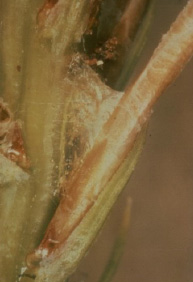
Figure 4. Resin capsule indicating attack point of young pine tip moth larvae (photo by R. Scott Cameron)
The impact of Nantucket pine tip moth attack on pine growth can be significant. Tip moth larval feeding causes bud and shoot mortality which results in tree deformation, reduced height and diameter growth, and occasionally tree mortality (Figs. 5 & 6). Loss of tree form is common where heavy attacks cause forks, crooks, or multiple trunks. Damage is generally most severe on seedlings and saplings under five years of age and 15 feet (4.6 m) tall, but decreases as crowns close. However, severe attacks on commercial-sized trees have been reported.Loblolly pine protected from tip moth attack for 2 years in the Western Gulf Region had 64% more volume than unprotected trees at age five (D.Grosman, unpublished data). Ten years after planting on northeast Florida sandhills, unprotected loblolly pine trees were 9 feet shorter in height, 1.5 inches smaller in dbh, and had about one forth as much wood as protected pines. C.W. Berisford (University of Georgia, unpublished data) found that pine trees protected from Nantucket pine tip moth attack grew significantly faster than unprotected trees during the first 6 years after planting and that volume differences (30%) between protected and unprotected trees were still increasing after 15 years in Georgia and North Carolina.
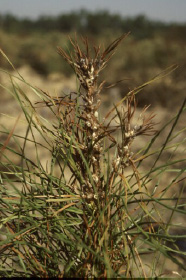
Figure 5. Loblolly pine shoots with multiple attacks by pine tip moth. (Photo by Don Grosman)
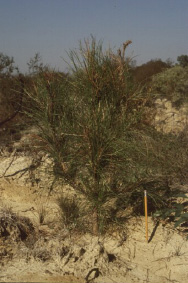
Figure 6. Loblolly pine tree (second year) extensively damage by pine tip moth (note bushy appearance). (Photo by Don Grosman)
Technological developments in pine plantation management and tree improvement programs within the past three decades have dramatically increased rates of tree growth. Intensive management of southern pines typically includes thorough mechanical site preparation and/or one or more herbicide applications plus fertilization on most sites. Although these practices increase tree growth, sometimes dramatically, they can exacerbate tip moth attacks and prevent realization of potential tree growth. Several studies have evaluated the influence of stand management practices or growing conditions on tip moth infestation and tree damage levels. Tip moth levels have been observed to be higher in plantations compared to natural stands, in plantations with the widest tree spacing, and are positively correlated with intensity of site preparation, weed control, and fertilization. A recent survey of over 200 sites in the Western Gulf region also found a significant increase in tip moth damage as silvicultural intensity (i.e., site preparation, weed control and fertilization) increased (Don Grosman, unpublished data).
More than 30 known species of parasites attack the pine tip moth. Several predatory insects and birds also attack this pest. Low winter temperature in the northern part of the range can kill overwintering pupae. Certain cultural practices may be used to minimize damage done by this insect. Highly susceptible species of pine should be planted only on sites to which they are well adapted. On poor sites, species of pine resistant to Nantucket pine tip moth should be substituted if possible. Such practices as close spacing and planting under an overstory may help reduce moth populations and subsequent injury to trees.
Because of the high cost, the benefit/cost ratio is small for large-scale treatments. Control by insecticides is usually only economically feasible in cases where damage is especially severe and unit value of trees is high, i.e., seed orchards, progeny test sites, Christmas tree plantations, or on ornamentals. A number of insecticides are currently registered for use against pine tip moth. However, only bifenthrin (OnyxPro), carbaryl (Sevin), diflubenzuron (Dimilin), esfenvalerate (Adjourn, Asana XL), fipronil (PTM), imidacloprid (Garant, SilvaShield), lambda cyhalothrin (Lambda-T, Silencer), permethrin (Dragnet, Pounce), spinosad (Conserve, Entrust, SpinTor, Success) and tebufenozide (Confirm) can be applied in forested areas. Some are applied to pine foliage and others, which are systemic insecticides, are applied to the soil.
If foliar sprays are used and season-long control is desired, spraying may be necessary for each generation. Effective use of pesticides is dependent on precise timing for spraying, which should be carried out after eggs are laid up until second instar larvae are present. This is the only period of time when young larvae feed on the exterior of the shoot. Ordinarily, pheromone-baited traps have been used to determine time of spraying. In areas where tip moth have 3 – 4 generation per year trees should be sprayed ten days after the first adult moth is captured (eggs hatch 5 to 10 days after the peak of adult emergence). This must be repeated for each generation. However, a model was recently developed to easily predict the optimal spray interval prior to each Nantucket pine tip moth generation at numerous sites across the South (Fettig et al. 2000* and 2003**) without the need for population monitoring.
To make control of tip moth economical in large forest plantations, a systemic chemical is needed that can be applied when seedlings are planted or after planting and can protect seedlings for 2 or more years. Two new systemic insecticides (PTM and SilvaShield Forestry Tablet) have been registered recently and have been shown to meet the criteria mentioned above. Unlike foliage sprays that tend to provide immediate protection against insect pests, systemics require adequate soil moisture and some period of time to be taken up by the plant roots and transported to the areas of the plant where insects feed. Thus, systemic insecticide applications should be made one to three months prior to insect exposure. PTM solution is applied with soil injectors (Kioritz or PTM Spot Gun, Fig. 7A & B) at planting or next to seedlings after planting. The SilvaShield Forestry tablets (Fig. 8) can be deposited into plant holes or pushed into the soil next to seedlings.
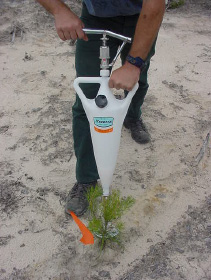
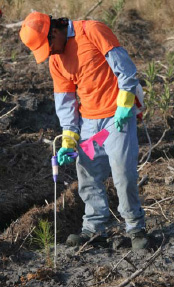
Figure 7. Kioritz (A) and PTM spot gun (B) soil injectors for application of PTM solution. (Photos by Don Grosman & Harold Quicke, BASF)

Figure 8. SilvaShield Forestry Tablets (Photo by Don Grosman)
For more information on pine tip moth or control methods, contact L. Allen Smith, Regional Forest Health Coordinator, Texas A&M Forest Service by phone at (903) 297-5094 or email at lasmith@tfs.tamu.edu.
* http://www.srs.fs.usda.gov/pubs/rp/rp_srs018.pdf
** http://www.srs.fs.usda.gov/pubs/rp/rp_srs032.pdf
Literature Cited:
Asaro, C., C. J. Fettig, K. W. McCravy, J. T. Nowak and C. W. Berisford. 2003. The Nantucket pine tip moth
(Lepidoptera: Tortricidae): A literature review with management implications. J. Entomol. Sci. 38: 1-40.
Fettig, C. J., M. J. Dalusky, and C. W. Berisford. 2000. Nantucket pine tip moth phenology and timing of insecticide
spray applications in seven southeastern states. USDA Forest Service, SRS Res. Paper. 18. 21 pp.
Fettig, C. J., J. T. Nowak, D. M. Grosman and C. W. Berisford. 2003. Nantucket pine tip moth phenology and timing of
insecticide spray applications in the Western Gulf Region. USDA Forest Service, SRS Res. Paper. 32. 13 pp.
Yates III, H. O., 1960. The Nantucket pine tip moth. A literature review. US For. Serv. SE For. Exp. Stat., Stat. Pap.
No. 115. Asheville, NC. 19 p.
Yates III, H. O., N. A. Overgaard, and T. W. Koerber. 1981. Nantucket Pine Tip Moth. USDA Forest Service,
Forest Insect and Disease Leaflet 70.